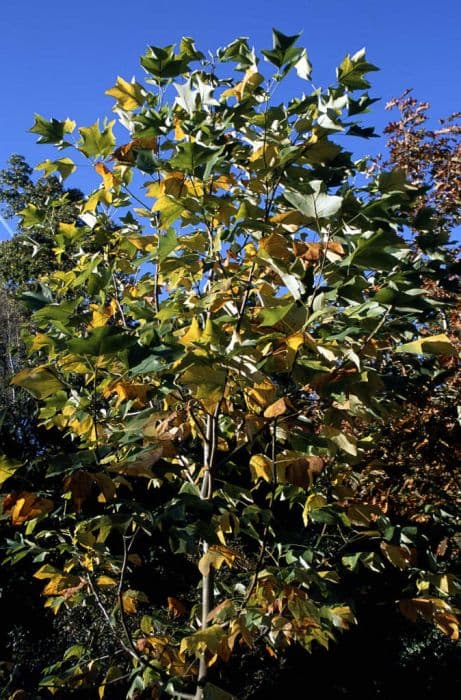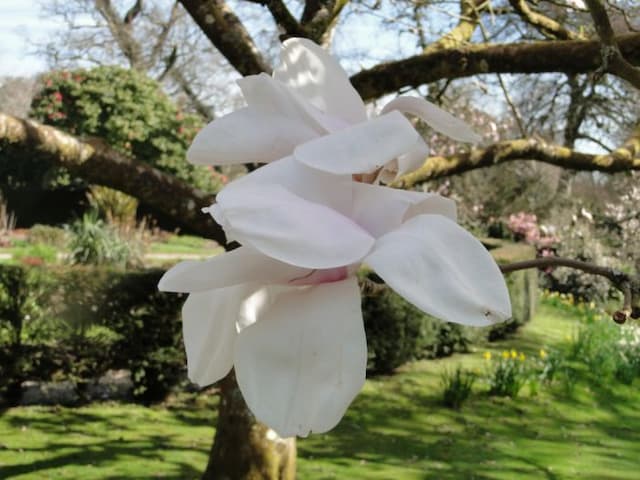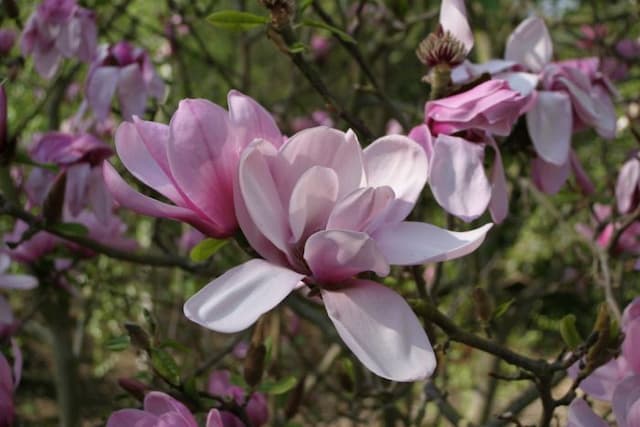Magnolia 'Eric Savill' Magnolia sprengeri var. diva 'Eric Savill'

ABOUT
'Eric Savill' is a deciduous tree to 12m tall, with rich pink flowers to 20cm across, in spring, the tepals paler to white within
About this plant
 Names
NamesFamily
Magnoliaceae
Synonyms
Eric Savill Magnolia, Diva Magnolia
Common names
Magnolia sprengeri var. diva 'Eric Savill'.
 Characteristics
CharacteristicsLife cycle
Perennials
Foliage type
Deciduous
Color of leaves
Green
Flower color
Pink
Height
20 feet (6 meters)
Spread
15 feet (4.5 meters)
Plant type
Tree
Hardiness zones
7
Native area
China
Benefits
 General Benefits
General Benefits- Ornamental Value: Magnolia sprengeri diva 'Eric Savill' has large, showy flowers that make it a stunning addition to ornamental gardens and landscapes.
- Spring Interest: With its early spring blossoms, it provides color and interest after a long winter, signaling the start of the growing season.
- Aromatic Flowers: The blossoms have a pleasant fragrance that can enhance the sensory experience in a garden setting.
- Shade Provision: As it matures, this magnolia can provide shade in gardens and parks, creating a cooler microclimate during hot seasons.
- Habitat for Wildlife: The flowers attract pollinators like bees, while the tree itself provides shelter and nesting sites for birds.
- Year-Round Interest: Besides the spring flowers, this magnolia has attractive foliage in summer, which can change to striking colors in the fall, and its form provides structure in the winter landscape.
- Durability: Magnolia sprengeri diva 'Eric Savill' is known for being a hardy plant, capable of withstanding difficult growing conditions once established.
- Cultural Significance: Magnolias are often associated with nobility and dignity and have been popular in gardening and landscaping for centuries.
 Medical Properties
Medical PropertiesThis plant is not used for medical purposes.
 Air-purifying Qualities
Air-purifying QualitiesThis plant is not specifically known for air purifying qualities.
 Other Uses
Other Uses- Magnolia Sprengeri 'Eric Savill' petals can be used in gourmet culinary dishes, providing a unique appearance and subtle flavoring to exotic salads or as an edible garnish.
- The wood of Magnolia Sprengeri 'Eric Savill' is sometimes used in furniture making or woodcrafts, appreciated for its fine texture and workability.
- This magnolia's large, sturdy leaves can serve as a natural wrapping material for small parcels or as biodegradable serving plates at eco-friendly events.
- The tree can be cultivated for ornamental display beyond gardens, in urban landscaping projects to provide aesthetic value and enhance public spaces.
- Young branches and twigs may be utilized in the creation of rustic handcrafted items, such as woven baskets or decorative wreaths.
- Fallen petals and leaves can contribute to compost heaps, enriching soil as they decompose due to their organic matter content.
- The bark of the Magnolia Sprengeri 'Eric Savill' can be used in tanning processes, although not commonly, to produce leather goods with certain tannin qualities.
- The scent of the flowers might be used in making natural, plant-based perfumes, giving off a light, sweet fragrance that is not overpowering.
- Horticulture enthusiasts may collect and trade seeds or cuttings of rare magnolias like 'Eric Savill' as a hobby to preserve and diversify plant genetics.
- The tree can act as a natural sound barrier when used in landscaping because of its dense foliage, thus effectively reducing noise pollution in suburban areas.
Interesting Facts
 Feng Shui
Feng ShuiThe Magnolia is not used in Feng Shui practice.
 Zodiac Sign Compitability
Zodiac Sign CompitabilityThe Magnolia is not used in astrology practice.
 Plant Symbolism
Plant Symbolism- Purity: The Magnolia's large, white blossoms are often associated with the notion of purity, representing innocence and clean beauty.
- Perseverance: Magnolias are known for their ability to survive harsh conditions, symbolizing endurance and strength in the face of adversity.
- Dignity: The stately appearance and grandeur of the Magnolia tree represents a dignified and noble spirit.
- Femininity: With its delicate appearance and gentle fragrance, the Magnolia is often seen as a symbol of femininity and softness.
- Love of Nature: The Magnolia's connection to the outdoors and its place in natural settings symbolizes a deep appreciation for and connection to nature.
 Water
WaterThe Eric Savill Magnolia should be watered thoroughly, allowing the soil to be moist but not waterlogged. During the growing season, water this magnolia once a week with about 1-2 gallons, depending on the size of the plant and the weather conditions. Reduce watering to every two weeks or less during the dormant winter period, but ensure the soil does not completely dry out. Always check the soil moisture at a depth of a few inches to determine if additional water is needed. Overhead watering is not advised; instead, water at the base of the plant to avoid wetting the foliage.
 Light
LightThe Eric Savill Magnolia thrives in a spot with full sun to partial shade. It should receive at least 4 hours of direct sunlight but will appreciate some afternoon shade in hotter climates. The plant can be affected by leaf scorch if exposed to excessive sunlight in peak summer, so a location that provides a balance of sunlight and dappled shade throughout the day is ideal.
 Temperature
TemperatureEric Savill Magnolias prefer temperate climates and can tolerate a wide range of temperatures. They do best in areas where temperatures range from 60 to 80 degrees Fahrenheit. However, they are hardy and can survive brief periods of temperatures as low as 20 degrees Fahrenheit. It's important to protect the magnolia from extreme cold, as temperatures well below freezing can damage the buds and flowers.
 Pruning
PruningPrune the Eric Savill Magnolia to maintain shape and remove any dead or broken branches. The best time to prune is soon after the flowering period has ended, to minimize the impact on blooming. Light pruning can be done to enhance the tree's natural form. It is not necessary to prune every year; inspect the tree annually and prune as needed.
 Cleaning
CleaningAs needed
 Soil
SoilThe best soil mix for 'Eric Savill' Magnolia is one that is rich, moist, and well-draining with a slightly acidic to neutral pH of 5.5 to 7.0. An ideal mix would contain loamy soil, peat moss, and coarse sand or perlite to improve drainage.
 Repotting
Repotting'Eric Savill' Magnolia trees do not require frequent repotting and are typically repotted every few years when they are grown in containers; otherwise, they are generally planted directly into the ground.
 Humidity & Misting
Humidity & Misting'Eric Savill' Magnolia prefers moderate to high humidity levels but is adaptable and can thrive in the varying outdoor humidity conditions typical of the climates where it grows well.
 Suitable locations
Suitable locationsIndoor
Provide bright, indirect light and avoid dry heat sources.
Outdoor
Plant in well-draining soil; partial to full sun.
Hardiness zone
6-9 USDA
 Life cycle
Life cycleThe Magnolia sprengeri var. diva 'Eric Savill', also known simply as 'Eric Savill' magnolia, begins its life cycle as a seed, which after stratification, germinates in spring. The seedling stage involves the establishment of roots and the initial shoot growth, which then develops into a juvenile tree. This juvenile phase is marked by rapid vegetative growth and the absence of flowering. As the plant matures, it enters the adult stage, where it becomes capable of flowering and sexual reproduction; this typically occurs after several years of growth. Each spring, 'Eric Savill' magnolia produces large, pink, showy flowers before the leaves, which are followed by the development of cone-like fruit that contains the seeds. The mature tree can live for many decades, continuing to grow in size and produce flowers annually, with eventual senescence and decline in reproductive and vegetative vigor as it reaches the end of its lifespan.
 Propogation
PropogationPropogation time
Spring-Early Summer
Magnolia sprengeri var. diva 'Eric Savill' is commonly propagated through methods such as seed, cuttings, and grafting. However, the most popular and widely used method is grafting. This involves taking a cutting from a healthy 'Eric Savill' magnolia, typically a piece of stem around 4 to 6 inches long, and joining it to a rootstock of a different, but related, magnolia species. This is often done during the winter months when the plant is dormant. The grafted area is then wrapped to ensure it stays in place and to encourage the tissues of the scion and rootstock to fuse together. With proper care and conditions, the graft will take, leading to a new magnolia plant that combines the desired characteristics of 'Eric Savill' with the robustness of the chosen rootstock.









![Magnolia [Felix Jury]](/_next/image?url=https%3A%2F%2Fplants-admin.emdemapps.com%2Fimages%2Fplants%2F%2Fimages%2F604b61a0b23b7.png&w=640&q=75)